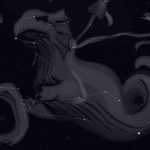| Meaning: | The Whale, the Sea Monster | Print out the star map from Sky and Telescope
Things to look for: Messier objects: Note: [x.x] indicates visual magnitude |
|
| Pronunciation: | see’ tus | ||
| Associated Asterisms: | The Head | ||
| % of the sky: | 2.99% | ||
| Visible Stars: | 58 stars brighter than magnitude 5.5 |


Cetus, the Sea Monster or Whale, is a big constellation; it is the 4th biggest in the skies. Its size isn’t everything though as it contains one Messier object and, being away from the Galactic plane, has many more distant galaxies to view; it has a number of New General Catalogue objects to brighten those dark nights including one with a Herschel connection.
Cetus sits South of the ecliptic, the line of the Sun, but only by a few degrees. Hence planets often wander below the ecliptic just enough to be within the constellations boundary. This is more true for smaller solar system objects such a asteroids with a larger variety of orbit inclinations. Vesta was discovered within Cetus.
Cetus contains several named stars although none brighter than 50th (β Cet) in the sky including Menkar (α Cet), Deneb Kaitos (β Cet) and Mira (o Cet). Mira is of particular interest as it was the first variable star discovered that varies in magnitude so much that it is only visible to the naked eye during certain times in its 331 day cycle. The star is a red giant varying between relative magnitudes of 3-4 and 8-10 although the maximum has been reported as bright as 2.1 during certain cycles. These changes made it very obvious to the earliest observers that something was special with this star. This pulsating variable became the archetype for the class Mira variables. The star changes size and surface temperature over the cycle and the later can be determined spectroscopically; it swells from 300 to 400 solar diameters over it’s cycle. The luminosity of the star doesn’t change over the cycle, just the emitted wavelength of light from visual to infrared. The star was named by Johannes Hevelius in his Historiola Mirae Stellae (1662) and it means wonderful. Mira is a double with a white dwarf companion.
The constellation also contains τ Ceti, the next nearest Sun-like star to Earth; only a short 12 light-year hop away. It is of the same spectral type, G, and 78% the mass of our Sun. It has a detectable debris disc around the star and potentially 5 planets with 2 that could support liquid water. Hence it is of interest to astrobiologists and SETI.


Cetus sits below Pisces with the sharp V of that constellation pointing at Mira and the neck of the Sea Monster. For some, it may be easier to imagine it as the Whale where the traditional Head becomes the fluked tail. Another way to find it is to follow the V, Hyades from Taurus down the neck of the bull to find the Head of Cetus.
In mythology, Cetus is the creature sent to take revenge for Cassiopeia’s boasting of her daughter’s beauty, Andromeda. Only Perseus’s intervention using the head of Medusa saved poor Andromeda from the planned fish supper.
Unlike many of the constellations written about earlier, Cetus has no associated annual meteor showers.


M77 is side on barred spiral galaxy with a general magnitude of 9.6 and a nucleus of 10. It lies almost 50 million light-years distant and is nearly twice as wide as the Milky way at 175,000 light-years. You’ll need a telescope to see it but finding it is reasonably easier as a short star hop from δ Ceti. Almost in the same field of view is NGC 1055, an edge on spiral galaxy with clear dust lanes visible. It and M77 are a binary system separated by 442,000 light-years. NGC1055 is the smaller partner with a width of 115,000 light-years but imagine the night skies from planets within each galaxy, spectacular. NGC 1055 is of some note as it was discovered by William Herschel in 1783.

